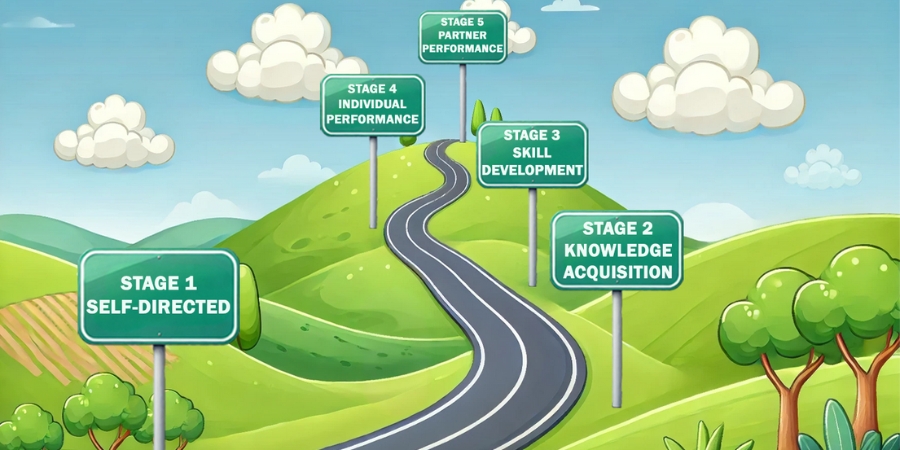In the fast-paced world of modern business, organizations increasingly rely on a vast network of partners, suppliers, distributors, and customers to drive growth and stay ahead of the competition. These extended networks are crucial for success, and effective training programs are essential to ensure everyone is aligned, performing well, and following the same rules.
However, extended enterprise training isn’t exactly a walk in the park. It’s more like a trek up Mount Everest, filled with challenges that require careful planning, the right tools, and a lot of determination.
So, what are these challenges? Let’s lace up our virtual hiking boots and take a closer look. At a high level, they include:
- Geographically Dispersed Partners
- Brand and Product Lines
- Field Support Networks
- Multi-role Learners
- Diverse Audiences and Learning Needs
- Cultural Differences
- Engagement and Motivation
- Compliance and Regulatory Requirements
- Language Barriers
- Adapting to Rapid Changes
The challenges of extended enterprise training are like the rocky terrain at the start of a climb—unavoidable and often underestimated. Partners are spread across the globe, making it tricky to deliver consistent training. Different brands and product lines can confuse even the most seasoned partners. And don’t even get us started on the field support networks—they require a whole other level of coordination!
But fear not, because just like climbing Everest, extended enterprise training can be broken down into manageable stages. Each stage brings new challenges, but also new rewards. The higher you climb, the better the view—and the greater the impact of your training program.
What Is Extended Enterprise Training?
Stage 1: Self-Directed Training Program
This is the first checkpoint. The Self-Directed Training Program is the foundation of your journey, much like the base camp of Everest. Here’s where your partners get their first taste of independence. Imagine handing them a map, a compass, and a hearty “Good luck!” and watching as they embark on their training adventure.
This stage is all about empowering partners to take control of their own learning. It’s the choose-your-own-adventure book of the training world, where partners can decide what they need to know and when they need to know it. But here’s the catch—just like navigating through the wilderness, it’s easy for partners to get lost or only learn what they think is necessary, which may not always be enough.
Goal
Provide partners with the resources, tools, and flexibility they need to acquire knowledge at their own pace, enabling them to effectively sell, service, and use your organization’s products.
Benefit
A self-directed program sets the stage for a more robust learning environment. It helps partners gain knowledge on their terms, which can lead to better engagement and retention.
Challenge
The downside? Partners might only dip their toes in the water instead of diving deep, leading to incomplete knowledge transfer and skill development.
Best Practices
- Provide Comprehensive Training Resources: Offer a buffet of learning materials—videos, articles, interactive modules—so partners can pick and choose what suits their tastes.
- Blended Learning: Mix self-paced and instructor-led courses to ensure a balanced diet of knowledge.
- Suggest Training: Act as a guide by suggesting courses and learning paths based on the partner’s role and history.
- Implement an Extended Enterprise LMS: A Learning Management System (LMS) is like the GPS of your training program, tracking progress and guiding partners along the way.
- Learner Feedback: Encourage feedback to fine-tune the content and make the journey smoother for future travelers.
- Regular Updates: Keep your materials fresh and relevant—stale content is like carrying outdated maps.
- Recognize Learners: A little recognition goes a long way—think of it as a well-earned badge of honor for your partners.
- Measure Success via Enrollments: Track enrollments and content consumption to see how well your program is working.
Case Study
The Future of Extended Enterprise Learning for Partner Networks
Read the Case StudyStage 2: Knowledge Acquisition Training Program
Having successfully navigated the base camp, it’s time to ascend to the next level—Knowledge Acquisition. This stage is where your partners move beyond self-navigation and start diving into the nitty-gritty details. It’s like swapping your map and compass for a guided tour where the focus is on building a strong foundational understanding.
In this stage, learners go from casual explorers to serious students. They’re not just picking up bits and pieces anymore; they’re engaging in structured learning designed to make them experts in selling, servicing, and using your products.
Goal
Establish a consistent baseline of knowledge across all partners. Think of it as making sure everyone has the same solid footing before climbing higher.
Benefit
- Higher Customer Satisfaction: Knowledgeable partners make for happier customers, which in turn leads to more loyalty.
- Improved Consistency: Standardized training ensures everyone’s on the same page, leading to more uniform performance across the board.
Challenges
- Engagement and Motivation: Keeping partners motivated can be as tough as climbing a steep incline—especially when the path is prescribed.
- Assessment Accuracy: Designing assessments that truly measure knowledge acquisition can be tricky. You don’t want any false summits here!
Best Practices
- Create Certifications: Certifications are the milestones of your partner’s journey, marking their progress with tangible achievements.
- Assign Certifications: Automate the process to ensure no one misses out on their badge of honor.
- Partner Certification Objectives: Set targets for the number of certified staff per role—this keeps everyone aiming for the summit.
- Pre-Assessments: Use these to map out knowledge gaps before partners begin their ascent.
- Incentivize Training: Add a bit of excitement by rewarding those who reach their goals.
- Integrated Field Support: Blend the training with your existing support networks—think of it as having Sherpas along the way.
- Branded Partner Locations: Group learners by the products they handle—like setting up different camps for different routes up the mountain.
- Multi-Location Learners: Support partners who wear multiple hats and need to climb different peaks simultaneously.
- Manager Knowledge Feedback: Encourage managers to give feedback on the training’s impact, helping fine-tune the program.
- Measure Success via Certifications: Keep an eye on the number of certifications earned and partners meeting their objectives.
Stage 3: Skill Development Training Program
You’ve climbed higher, and now it’s time to equip your partners with the tools they need to conquer the mountain of Skill Development. At this stage, it’s all about moving from theory to practice. Partners learn not just what to do, but how to do it with finesse. It’s like going from learning about climbing techniques to actually scaling the rock face.
Goal
Equip partners with practical skills necessary for their roles, ensuring they can apply their knowledge in real-world scenarios. This is where the training gets hands-on and partners start to truly master their craft.
Benefits
- Higher Sales and Customer Satisfaction: Skilled partners are more persuasive in sales and more effective in service, leading to happier customers and higher profits.
- Lower Warranty and Support Costs: When partners can fix things right the first time, everyone wins—especially the bottom line.
- Improved Network Retention: Skilled partners are valuable, and they know it. High skill levels often lead to high retention rates within the network.
Challenges
- Varied Skill Levels: Just like every climber has their own pace, partners start with different skill levels, making it challenging to keep everyone on the same trail.
- Ensuring Practical Application: It’s one thing to learn a skill, another to apply it effectively in the field. You need to ensure that the skills partners acquire aren’t just theoretical but practical and actionable.
Best Practices
- Skill Profiles: Define the skills and proficiency levels required for each role, just like you would plan your ascent based on the terrain ahead.
- Assign Skill Levels: Automatically align skill levels with specific roles to keep partners progressing.
- Partner Skill Level Objectives: Set clear goals for the number of skilled staff per role—this keeps everyone focused on reaching the next camp.
- Skill Assessments: Evaluate skill levels with assessments that simulate real-world challenges.
- Regular Practice: Incorporate workshops, simulations, role-playing, and hands-on projects to let partners practice and refine their skills.
- Mentorship and Coaching: Provide access to experienced mentors or coaches who can offer personalized guidance, support, and feedback—your very own mountain guides.
- Encourage Peer Interaction: Facilitate forums, discussion groups, and peer reviews to enhance engagement and support—because climbing is more fun with a team.
- Incentivize Skill Development: Keep partners motivated by rewarding their progress and skill mastery.
- Manager Skill Level Feedback: Encourage managers to provide feedback on how well partners are applying their skills in the field.
- Measure Success via Skills Levels: Track the number of skilled learners and partners who achieve their skill level objectives.
Access LatitudeLearning, Free for 30 Days
Put LatitudeLearning to the test.
See why it’s the best LMS for extended enterprise training.
Learn more
Stage 4: Individual Performance Training Program
At this altitude, it’s time to zoom in on each individual climber with an Individual Performance Training Program. Now that partners have the skills, it’s all about honing their performance. This stage is like measuring how well each climber is handling the altitude and adjusting their pace to optimize their ascent.
Goal
Improve individual performance, productivity, and efficiency through targeted training and continual program improvements.
Benefits
- Higher Productivity and Efficiency: Better individual performance means more progress with less effort.
- Improved Training Program Effectiveness: Enhanced performance metrics lead to more significant results and a better return on training investment.
Challenges
Accurately measuring and tracking individual key performance indicators (KPIs) is like trying to gauge how well a climber is acclimatizing to the altitude—it requires precise tools and methods.
Best Practices
- Individual KPI Integration: Implement tools to track KPIs in real-time, providing a clear picture of each partner’s performance.
- Learner Discriminant Analysis: Use data to identify the training elements that best predict high performance.
- Assign KPI Training: Focus training on areas that will directly improve individual KPIs.
- Set Clear Performance Goals: Define measurable goals for each participant to strive towards.
- Improve Impact on Individual Performance: Adjust training programs to address areas where performance improvement is needed.
- Implement a Partner LMS that Supports KPIs: Ensure your LMS can integrate KPIs for tracking and analysis.
- Incentivize Individual Performance: Motivate partners by rewarding their achievements in performance.
- Measure Success via Individual Impact: Compare KPI improvements between trained and untrained participants to assess the program’s impact.
Stage 5: Partner Performance Training Program
You’ve reached the summit! The Partner Performance training program is the pinnacle of your journey, focusing on maximizing the overall performance of your partners. This stage is like standing at the top of Everest and surveying the landscape below—where every step up to this point now contributes to a comprehensive view of success.
Goal
Ensure partners have a well-rounded mix of knowledge, skills, and individual performance levels across their teams to optimize overall partner performance.
Benefits
- Optimized Partner Performance: The entire partner network performs at a higher level, leading to more significant achievements and better business outcomes.
- Increased Revenue and Profitability: Improved partner performance translates directly to better sales and customer satisfaction.
- Strengthened Partner Relationships: Stronger, more capable partners are more loyal and engaged, driving long-term success.
Challenges
Measuring and tracking partner KPIs requires reliable tools and consistent evaluation methods to ensure accuracy.
Best Practices
- Partner KPI Integration: Implement real-time tracking tools to monitor partner KPIs.
- Partner Discriminant Analysis: Use data to determine the staffing levels that best predict high partner performance.
- Assign Staffing Levels to Partners: Set specific staffing goals to help partners achieve optimal performance.
- Set Clear Partner KPI Goals: Ensure partner goals align with overall business objectives.
- Improve Impact on Partner Performance: Adjust training programs to address areas where partner performance can be enhanced.
- Incentivize Partner Performance: Motivate partners to reach their goals with rewards and recognition.
- Measure Success via Partner Impact: Compare KPI improvements among trained and untrained partners to gauge the program’s effectiveness.
Drive Business Growth with Extended Enterprise Training
Take a look at your organization’s unique extended enterprise training program. Where do you land on the evolutionary climb to greater success? Research shows that partner training is the most effective strategy to increase partner performance, but not all training programs are created equal.
Different types of training programs have different levels of effectiveness. If you are interested in predicting how your partners will perform, rely on training. Your partners will become more effective while increasing productivity, revenue, and profits.
By following this Partner Training Program Roadmap and implementing each stage effectively, organizations can ensure that their partners are well-equipped to drive growth and maintain competitiveness in the modern business landscape.
So, strap on your climbing boots, pack your gear, and start your ascent. The view from the top is worth it!
Extended
Enterprise
Learning
Building Capabilities and Driving Performance Across the Value Chain
Get the eBook




